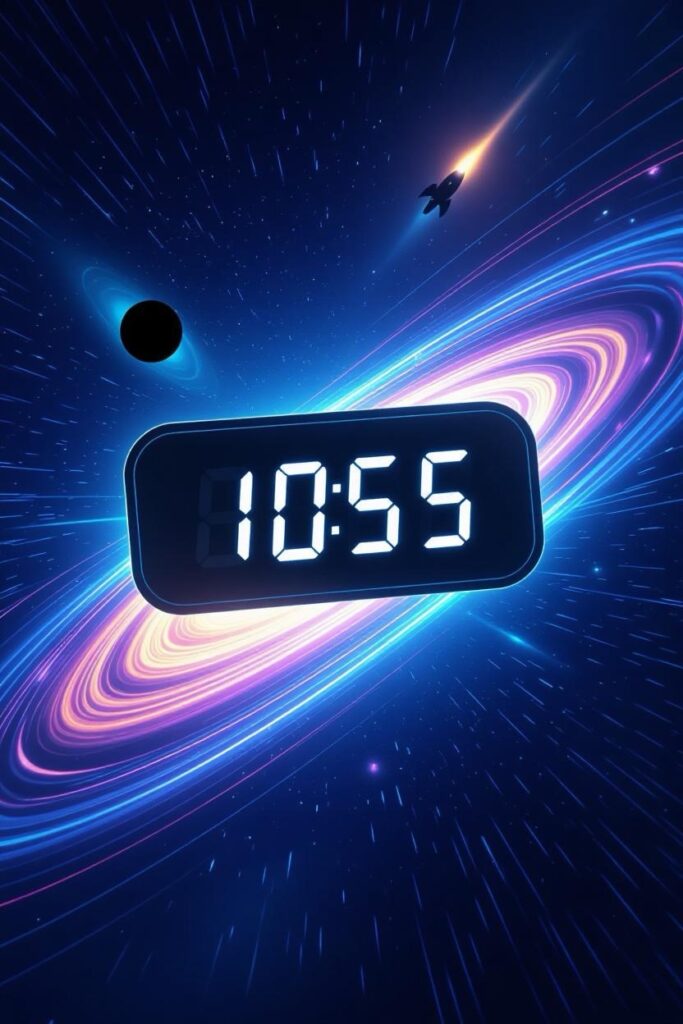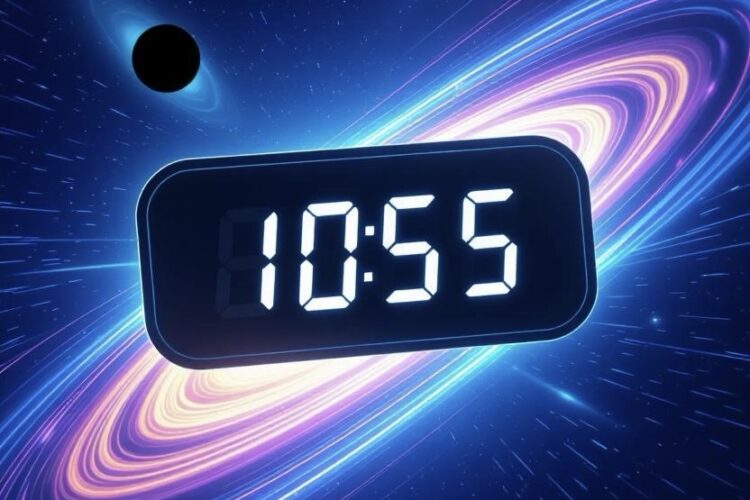Time dilation, a key concept in Einstein’s relativity, explains why time stretches for objects moving fast or in strong gravitational fields. In special relativity, time slows for a moving observer relative to a stationary one, as shown by the Lorentz factor, where higher speeds near the speed of light stretch time more. For example, muons from cosmic rays last longer due to their high velocity. In general relativity, gravity slows time; clocks tick faster at higher altitudes or near black holes, as seen in GPS satellites needing daily corrections. Experiments like flying atomic clocks on jets confirm both velocity and gravitational effects. Time dilation impacts space travel, technology, and our understanding of spacetime, proving time isn’t fixed but bends with motion and mass.
Long Version
Why Does Time Stretch? A Deep Dive into Time Dilation
In the realm of physics, time dilation challenges our everyday intuition about the passage of time. This phenomenon, rooted in Albert Einstein’s theories of relativity, describes how time can slow down for one observer relative to another due to differences in velocity or gravitational fields. Time is not an absolute constant but intertwined with space in a fabric called spacetime. Time dilation stems from the invariance of the speed of light, a universal speed limit that remains constant for all observers regardless of their motion.
Time Dilation in Special Relativity
Special relativity, introduced in 1905, posits that the laws of physics are the same in all inertial frames—non-accelerating reference systems. Time dilation occurs primarily due to relative velocity. Imagine two observers: one stationary and another moving at a significant fraction of the speed of light. For the moving observer, time appears to pass normally, but from the stationary perspective, the moving clock ticks slower. This is known as dilated time, contrasting with proper time, which is the time measured in the rest frame of the clock itself.
Consider the light clock thought experiment. A light clock consists of two mirrors with a photon bouncing between them. In a stationary frame, the light travels vertically, but for an observer watching a moving light clock, the path appears diagonal due to the relative motion. This longer path means the light takes more time to complete a cycle, leading to time dilation. Mathematically, this is captured by the Lorentz factor, γ = 1 / √(1 – v²/c²), where v is the relative velocity and c is the speed of light. As v approaches c, γ increases, stretching time dramatically.
A famous example is the twin paradox, where one twin embarks on a high-speed space journey involving acceleration and deceleration, while the other remains on Earth. Upon return, the traveling twin has aged less due to the effects of special relativity during the high-velocity phases. This resolves when accounting for the non-inertial aspects of the journey, confirming that the inertial observer on Earth experiences more proper time.
Muons, subatomic particles produced by cosmic rays colliding with Earth’s atmosphere, provide a real-world demonstration. These particles have a short lifetime at rest, yet, traveling near the speed of light, their dilated time allows them to reach the surface before decaying, far more than classical physics would predict. Length contraction, a companion effect where objects shorten in the direction of motion, ties into this, as both arise from the same relativistic transformations.
Gravitational Time Dilation in General Relativity
General relativity, developed in 1915, incorporated gravity, describing it as the curvature of spacetime caused by mass and energy. Time dilation manifests differently here: clocks tick slower in stronger gravitational fields. This gravitational time dilation predicts that time passes more quickly at higher altitudes, away from Earth’s gravitational pull.
The effect is linked to gravitational redshift, where light climbing out of a gravity well loses energy, shifting to longer wavelengths. Near a black hole, spacetime curvature is so extreme that time dilation can make seconds for an infalling observer equate to eons for a distant one. Atomic clocks have verified this; experiments with gamma rays emitted from a lower height showed a redshift consistent with general relativity’s predictions.
Acceleration also plays a role, per the equivalence principle, equating accelerated frames to gravitational ones. The clock hypothesis assumes that a clock’s rate depends only on its instantaneous velocity, not acceleration history, a cornerstone validated in particle accelerators. Redshift observations in astrophysics further support this, as light from distant galaxies reveals gravitational influences on time.
Key Experiments Confirming Time Dilation
Rigorous testing has solidified time dilation’s reality. In 1971, an experiment flew atomic clocks eastward and westward on commercial jets, measuring discrepancies due to both velocity and gravitational effects. Eastward clocks lost time from higher effective speeds (adding Earth’s rotation), while westward gained slightly, aligning with predictions after accounting for general relativity.
GPS satellites exemplify practical implications: orbiting at high speeds and altitudes, their clocks experience both special relativistic slowing from velocity and general relativistic speeding from weaker gravity. Without corrections—factoring in about 38 microseconds daily—GPS accuracy would degrade rapidly, leading to positioning errors of kilometers. Recent advancements, like 2022 millimeter-scale measurements with strontium atomic clocks, have pushed precision further, detecting tiny gravitational shifts over mere millimeters.
Other tests include experiments for transverse Doppler effects and muon lifetimes, all corroborating relativity.
Broader Implications and Cultural Resonance
Time dilation extends beyond labs into cosmology and technology. In black holes, it contributes to event horizons where time seemingly freezes for external observers. A popular movie dramatized this: characters near a massive black hole experience hours while years pass elsewhere, highlighting gravitational redshift and time’s relativity.
For space travel, cosmonauts have aged milliseconds less due to orbital velocities, a subtle but measurable effect. In quantum systems, time dilation intersects with decoherence, offering insights into fundamental physics.
Ultimately, time dilation reveals time’s malleability, woven into spacetime’s fabric. From cosmic rays to GPS, it underscores Einstein’s genius, providing tools for navigation, particle physics, and our grasp of the universe. As experiments refine our knowledge, relativity remains a pillar of modern science, reminding us that reality bends with motion and mass.

Time isn’t absolute—Einstein showed it bends with speed and gravity, reshaping how we experience the universe itself.
Hashtags For Social Media
#TimeDilation #Relativity #Einstein #SpecialRelativity #GeneralRelativity #Physics #Science #Astronomy #Astrophysics #Spacetime #BlackHoles #CosmicRays #Muons #GPS #AtomicClocks #SpaceTravel #TheoryOfRelativity #LorentzFactor #QuantumPhysics #Universe #Cosmos #ScienceFacts #PhysicsLovers #EinsteinTheory #GravitationalTimeDilation #VelocityTimeDilation #RelativisticSpeed #HafeleKeatingExperiment #Interstellar #MindBlown
Related Questions, Words, Phrases
why does time stretch? | what causes time to stretch in physics? | explain time dilation simply | how does relativity make time stretch? | why does time slow near speed of light? | what is gravitational time dilation? | why does gravity affect time passage? | einstein’s explanation for time stretching | what is the twin paradox in relativity? | how does high speed impact time? | time dilation formula and examples | real life instances of time stretching | why do moving clocks run slower? | understanding spacetime and time dilation | velocity’s effect on time measurement | how black holes cause time to stretch | gps satellites and time dilation fixes | muon decay as proof of time dilation | what is the light clock thought experiment? | role of lorentz factor in time dilation | proper time vs dilated time differences | does acceleration stretch time? | details of hafele-keating time experiment | science behind interstellar time dilation | kip thorne on gravitational time stretching | quantum mechanics and time dilation links | time dilation basics in special relativity | general relativity’s take on time dilation | why is time relative according to einstein? | how to calculate time dilation effects | history of discovering time stretching | experiments confirming time dilation theory | time dilation implications for space journeys | resolving paradoxes in time dilation | beginner guide to why time stretches in physics






